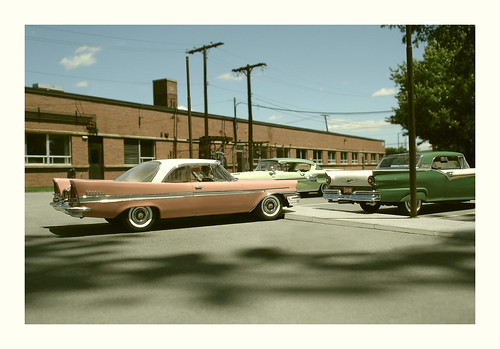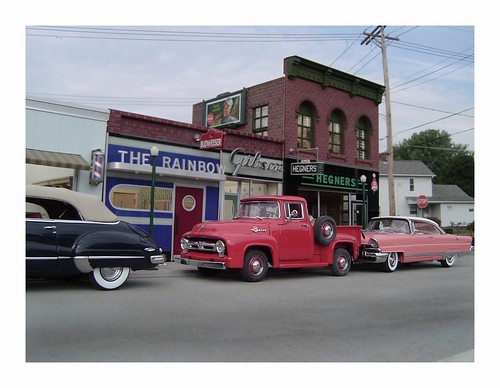
Location: New York Times Web Site
Photos Courtesy of Michael Paul Smith's Flickr site
We usually think of virtual worlds in terms of avatars and special software. I've run across a popular virtual world that requires neither: one needs only a Web browser and nostalgia.
The Times reports how Michael Paul Smith's images of an imagined town, Elgin Park, have attracted a large audience at the photo-sharing site. Smith arranges die-cast cars from the Danbury Mint in settings that evoke Postwar, pre-Vietnam America, a time whose sunset I dimly recall and that often appears in my dreams.
Why the popularity? Smith has a great sensibility for architecture and photography. He knows how to pose his vehicles. But my take is that many of Smith's followers share a desire with folks who become so involved in Second Life and other virtual worlds: a sense of control.
America in the mid 60s, for white men at least, was still a place in command of its destiny (mutual assured destruction being the megaton of an exception). Smith's images capture those urban settings; even the cast of light is perfect. By dwelling on the quotidian, he also captures life as those older than 40 recall it. It's the most distant era many of us could imagine wanting to return to: reasonably modern medicine, technology, and media. Personally, the image above takes me back to hours waiting for my dad while reading Jack Kirby's and Stan Lee's Fantastic Four and other Marvel comics in our family's Edsel, then Star Chief, then Bonneville. It was safe to be alone in the car as dad did business with other produce dealers in large brick warehouses that did their best to look "Space Age" like many other businesses of that era.

Then we stopped going to the moon, and we began driving Japanese vehicles. I'm not critiquing the second of those changes, but they are there as markers of the end of American techno-triumphalism. Jay Leno feels that way, in a piece that accompanies the story of Elgin Park. Leno notes that when Chrylser sent its turbine-powered car on a world tour in 1963, "In countries where people were still riding bicycles and donkeys, Americans were driving jets."
Just as Leno can build a new one-off jet car, in virtual worlds we can create content not--and importantly, no longer--possible in real life. We can return to a past that has been perfected or a future that could never be: future nostalgia, in fact. Is it that different from the image below?

It's notable that Smith's photos lack people--who made that past so darned complex and doomed it to change. The convulsions of the 60s lay just beyond the range of these pictures.
It's also notable that the images of main street show a perfection that now has been lost to the hideous uniformity of suburban sprawl. Outback Steakhouse and its coast-to-cost homogenized cousins put The Rainbow Bar under, and Hegner's Paints got undercut by Home Depot and other blights on the cloned strips of America. Gradually, we've moved American commercial districts to uglier and uglier places than they inhabited in the methodical, human-scaled world that Smith depicts in 1/24 scale.
Smith's world is gone, but we have pictures. And if we cannot ever be dragon-slayers, vampires, rock stars, or I.M. Peis, we can at least have our avatars fill those roles.
1 comment:
Elgin Park was featured on the NBC Evening News tonight, Sunday 28 March 2010, and is as fascinating as anyone would expect it to be ...
A marvellous idea that takes many over the age of 50 back to their youth and those great days of the 1950s into the early 1960s ..
Thanks for mentioning it here on your blog, also.
Post a Comment